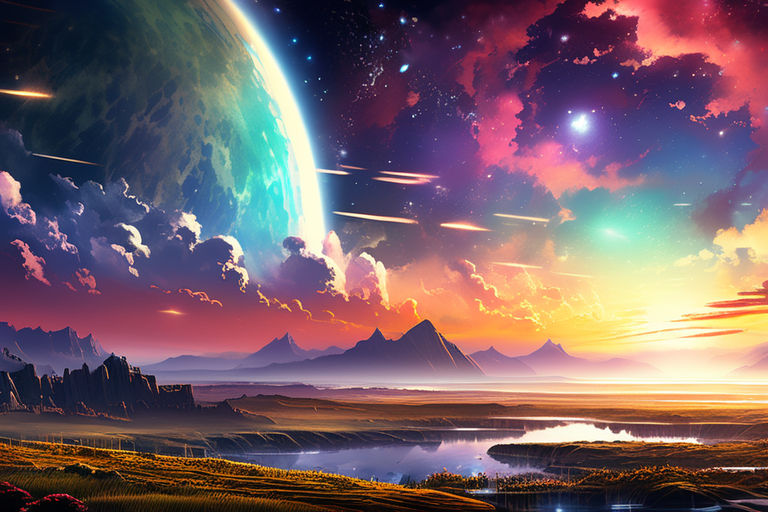Have you ever looked up at the night sky and wondered about the mysteries it holds? The stars, planets, and galaxies we see are just a glimpse into the vast universe that surrounds us. Astronomy, the study of celestial objects and phenomena, has fascinated humans for centuries. Whether you’re an avid stargazer or just curious about what lies beyond our planet, exploring the night sky can be a truly awe-inspiring experience.
The Beauty of the Milky Way
Our galaxy, the Milky Way, is a magnificent spiral of stars, dust, and gas that stretches across the sky. On a clear night, away from the city lights, you can see a hazy band of light that is actually the combined glow of billions of stars. This sight has inspired countless myths, legends, and works of art throughout human history.
The best time to observe the Milky Way is during the summer months in the Northern Hemisphere. Find a dark location, let your eyes adjust to the darkness, and look for the broad, faint ribbon of light stretching from one horizon to the other. It’s a reminder of our place in a vast, interconnected cosmos.
Stargazing Tips for Beginners
Getting started with stargazing is easier than you might think. You don’t need a telescope to enjoy the night sky; a pair of binoculars and a star chart can go a long way. Here are a few tips to help you begin your celestial journey:
1. Find a Dark Spot: Light pollution from cities can make it difficult to see stars. Try to find a location away from city lights, such as a park or countryside.
2. Check the Weather: Clear skies are essential for stargazing. Check the weather forecast before heading out.
3. Use a Star Chart or App: Star charts and mobile apps can help you identify constellations, planets, and other celestial objects. Some popular apps include Star Walk, SkyView, and Stellarium.
4. Be Patient: It takes time for your eyes to adjust to the darkness. Give yourself at least 20-30 minutes to fully adapt.
5. Take Notes: Keep a journal of your observations. Note the date, time, and location of your stargazing sessions, as well as the objects you observe.
The Phases of the Moon
The Moon, our closest celestial neighbor, goes through a cycle of phases every 29.5 days. These phases are a result of the changing positions of the Moon, Earth, and Sun. Understanding the phases of the Moon can enhance your stargazing experience.
1. New Moon: The Moon is between the Earth and the Sun, and its dark side faces us. This is the best time for stargazing because the sky is darkest.
2. Waxing Crescent: A sliver of the Moon becomes visible as it moves away from the Sun.
3. First Quarter: Half of the Moon is illuminated, and it appears as a half-circle.
4. Waxing Gibbous: More than half of the Moon is illuminated as it approaches full Moon.
5. Full Moon: The entire face of the Moon is illuminated. While beautiful, the full Moon’s brightness can make it harder to see faint stars.
6. Waning Gibbous: The Moon begins to wane, and less of it is visible each night.
7. Last Quarter: Half of the Moon is illuminated again, but on the opposite side.
8. Waning Crescent: A thin crescent of the Moon is visible before it returns to the new Moon phase.
The Planets: Our Solar System’s Jewels
The planets in our solar system offer some of the most spectacular sights in the night sky. With a bit of practice, you can spot them with the naked eye or through binoculars.
Mercury: The smallest planet, closest to the Sun, is often difficult to see because it stays close to the horizon. Look for it just after sunset or before sunrise.
Venus: The brightest planet, often called the “Evening Star” or “Morning Star,” is hard to miss. It’s usually the first “star” to appear in the evening and the last to fade in the morning.
Mars: Known for its reddish hue, Mars is best viewed when it is in opposition, meaning it is directly opposite the Sun in the sky.
Jupiter: The largest planet, with its four largest moons visible through binoculars. Look for its distinctive bands and Great Red Spot.
Saturn: Famous for its stunning ring system, Saturn is a favorite among stargazers. A small telescope will reveal its rings in detail.
Uranus and Neptune: These distant, icy giants require a telescope to see clearly. Uranus has a faint blue-green hue, while Neptune appears deep blue.
Meteor Showers: Nature’s Fireworks
Meteor showers occur when Earth passes through the debris left behind by comets. As these tiny particles enter our atmosphere, they burn up, creating bright streaks of light known as meteors. Some of the most well-known meteor showers include:
Perseids: Peaking in mid-August, the Perseids are one of the most popular meteor showers, known for their bright and frequent meteors.
Leonids: Occurring in mid-November, the Leonids are famous for producing meteor storms with hundreds of meteors per hour every 33 years.
Geminids: Peaking in mid-December, the Geminids are known for their bright, colorful meteors and are considered one of the best annual meteor showers.
The Magic of Eclipses
Eclipses are among the most dramatic celestial events you can witness. There are two main types of eclipses: solar and lunar.
Solar Eclipses: Occur when the Moon passes between the Earth and the Sun, casting a shadow on Earth. There are three types of solar eclipses: total, partial, and annular. Total solar eclipses, where the Sun is completely obscured by the Moon, are rare and spectacular events.
Lunar Eclipses: Happen when the Earth passes between the Sun and the Moon, casting a shadow on the Moon. During a total lunar eclipse, the Moon can take on a reddish hue, known as a “Blood Moon.”
Conclusion: A Universe Waiting to be Explored
The night sky is a vast, ever-changing tapestry of wonders. From the mesmerizing Milky Way to the dazzling planets and meteors, there’s always something new to discover. Whether you’re a seasoned astronomer or just starting your journey, the cosmos offers endless opportunities for exploration and inspiration. So, grab a blanket, find a dark spot, and let the universe reveal its secrets to you.



 Riddles are fun because they challenge our thinking and…
Riddles are fun because they challenge our thinking and…